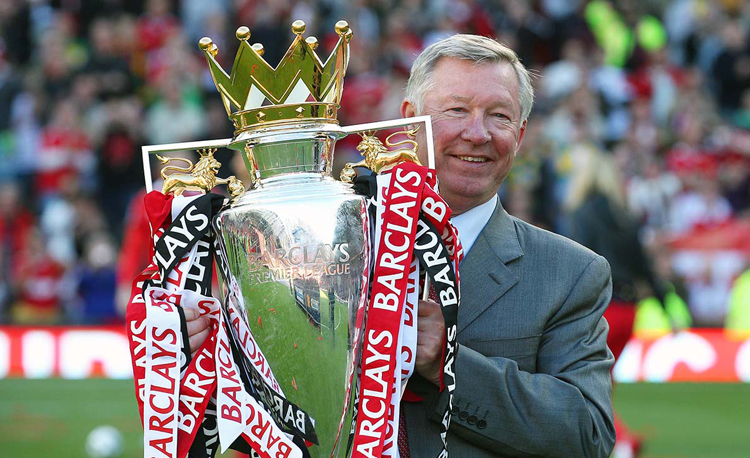




OUR BEST EVER OFFER - SAVE £100/$100
JOIN THE WORLD'S LEADING PROFESSIONAL DEVELOPMENT PROGRAMME
- 12 months membership of Elite Soccer
- Print copy of Elite Player & Coach Development
- Print copy of The Training Ground
My philosophy
My key football philosophy has always been to make sure my teams keep hold of the ball. The use of possession in creating space and reducing opposition threat is recreated in every match situation, so this knowledge is invaluable in the modern game. While the concept is straightforward, searching for improvement and development in this vital skill is important. There are a variety of challenges that enable us to perfect the art...
| Area | Up to a half-pitch |
| Equipment | Balls, cones, goals, poles |
| No. of Players | Up to 9v9 |
| Session Time |
Boxes 20mins, 6v6 20mins, Goals 20mins |
My key football philosophy has always been to make sure my teams keep hold of the ball. The use of possession in creating space and reducing opposition threat is recreated in every match situation, so this knowledge is invaluable in the modern game.
While the concept is straightforward, searching for improvement and development in this vital skill is important. There are a variety of challenges that enable us to perfect the art, and this practice can be embedded in more difficult game play situations by applying specific coaching exercises and conditions... encouragement to switch the ball, for instance.
At United, the players are so good at these activities it is a joy to watch. All players are comfortable receiving the ball and using space, from the goalkeeper right through the team.
Paul Scholes v Panathinaikos
Champions League, Second Group stage, Group A November 21, 2000, Old Trafford (1,2,3)
I have used the quick, tight, measured passing that you see in this session in my soccer training at Aberdeen and St. Mirren, right through to Manchester United. While there are countless examples of players who have excelled in this role, the performance that Paul Scholes put in against Panathinaikos in the Champions League at Old Trafford in 2000 was particularly special. We were leading 2-1 and looking to keep hold of the ball in order to see the game out. We not only achieved that, but constructed a passing move of more than 20 passes, which ended with a sublime Scholes chip over the goalkeeper and into the net.
1
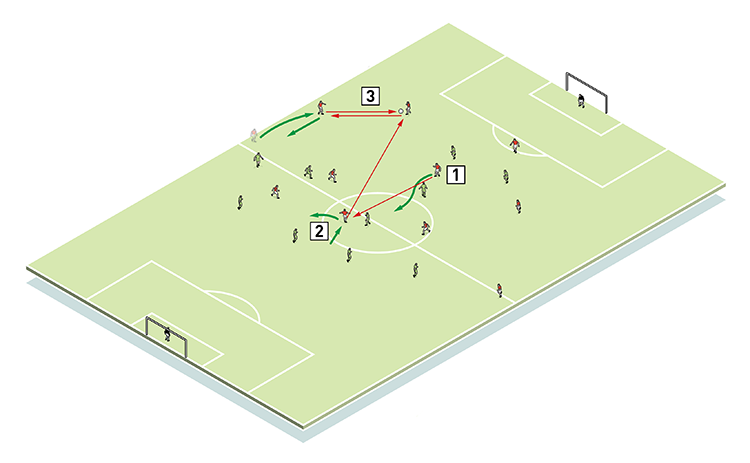
2. Sheringham lays it back to Mikael Silvestre
3. Mikael Silvestre and Wes Brown exchange passes
2
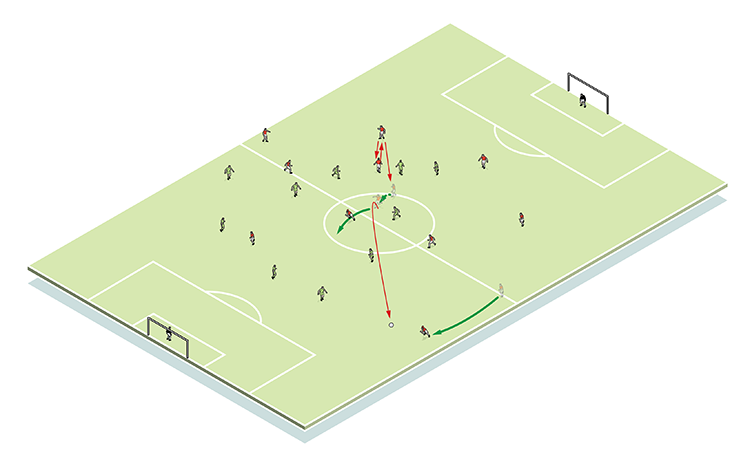
3
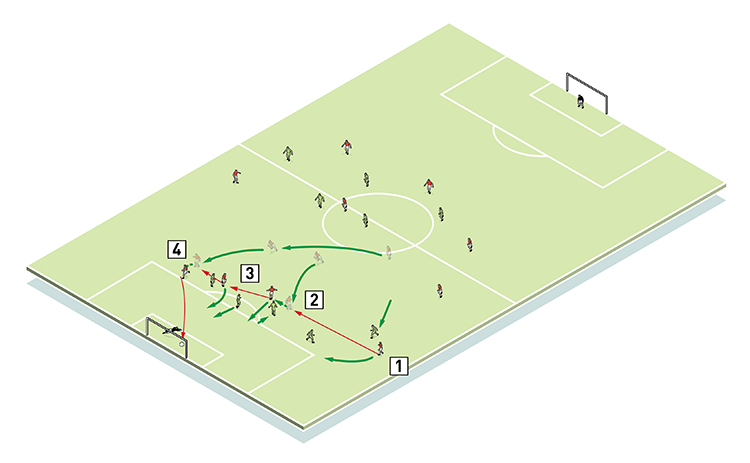
2. David Beckham has advanced into midfield and receives the pass
3. Teddy Sheringham flicks the ball to Paul Scholes who has made a blind side run
4. Paul Scholes takes one touch to control the ball then lifts it effortless over the Panathinaikos keeper for a memorable goal
Boxes (2a, 2b)
This involves the use of boxes as a primary start, something that is fundamental to players building understanding and motivation of movement and passing in tight areas. We use multiple boxes so that everyone is active.
A simple 4v2 in a 20x20-yard box is two-touch, ensuring players enjoy time on the ball. Blues work together to intercept while reds must retain possession using quick, efficient link-up, the use of angled runs and passes, and an appreciation of space. Players should operate on the balls of their feet, always ready to turn.
2a
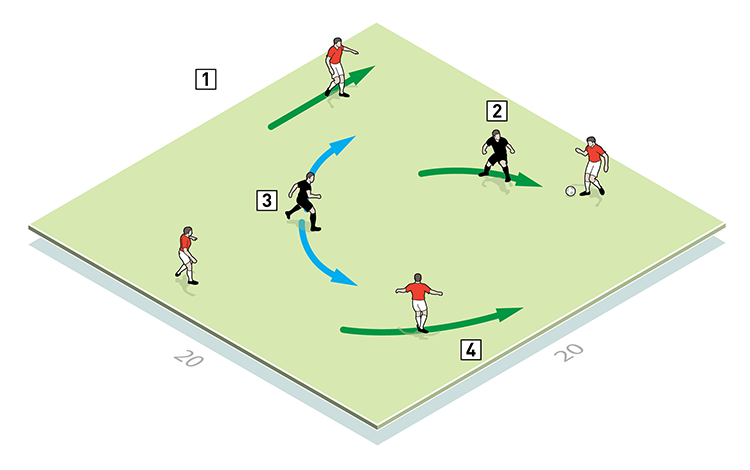
2. One blue closes down his opponent
3. The other blue prepares to move towards the next receiving player
4. Reds move closer to their team mate in possession to offer angled passing options
2b
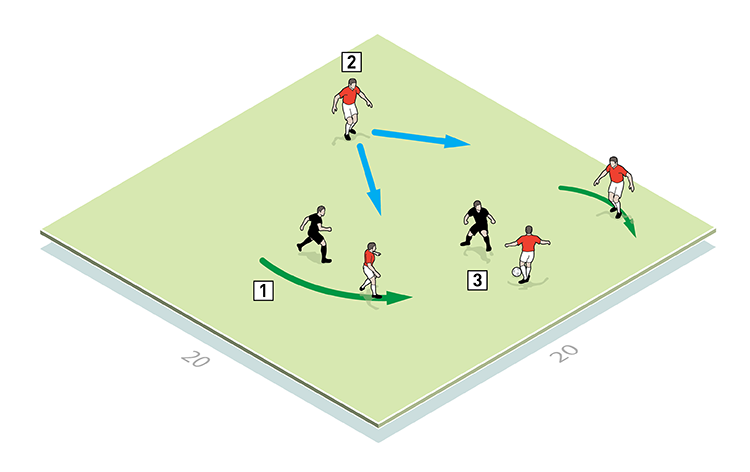
2. Now the red attacker must look for passing angles as blues press tightly
3. Blue presses the ball
Technique: Balls of the feet

How do I progress the game?
Progressions are always determined by the quality of the session at each stage, so, in this example, once we are sure sufficient progress is being made and a high quality of passing attained, we apply the same principles to one-touch 5v2. The adjustment of teams (to 6v2, 7v2 or even 6v3) or box size (right down to 10x10 yards) becomes part of the players’ motivation and entertainment as it is they who, through their actions, show they are ready for the more demanding parts of training. And remember, perseverance is vital for the creation of habit and expertise.
6v6 (not shown)
Next, we enlarge to a 40x40-yard box, playing 6v6. This is an evenly weighted practice that examines ball retention without the benefit of an overload.
Goals (3a, 3b)
Then, on a half-pitch and with a goal in each corner, players combine measured possession with goalscoring. They can score in any goal, though passes must be 18 yards or more.
To progress, we can add two gates, as extra goalscoring options, or as part of an instruction that the ball must be passed through a gate before a goal is attacked. Gates must be placed near the centre of the practice, no closer than 10 yards from each goal line.
3a
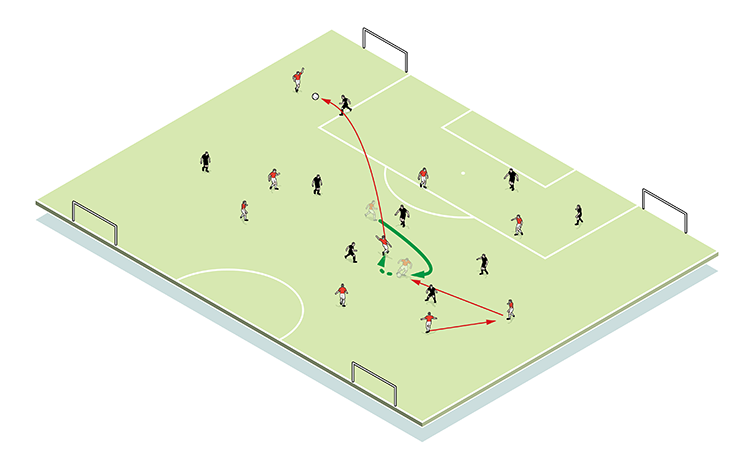
3b
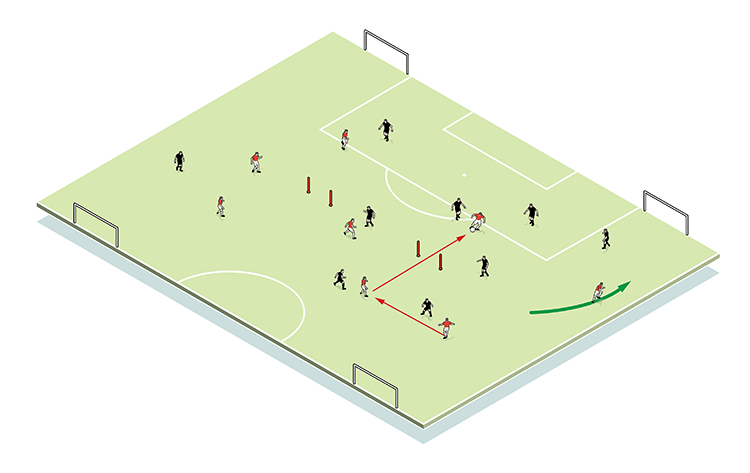
What are the key things to look out for?
In every part of this session, ensure players begin two-touch, with team mates always providing angles at which to receive the ball. The consistent pattern of movement should not be forgotten, and we want to see players using the balls of their feet... never flat-footed. And any player in possession must be pressured at all times, with excellent work rate throughout and no-one standing on the lines – that’s too easy.
Related Files
Editor's Picks
Attacking transitions
Deep runs in the final third
Using the goalkeeper in build-up play
Intensive boxes drill with goals
Penetrating the final third
Creating and finishing
My philosophy
Pressing initiation
Compact team movement
Coaches' Testimonials

Alan Pardew

Arsène Wenger

Brendan Rodgers

Carlos Carvalhal

José Mourinho

Jürgen Klopp

Pep Guardiola

Roy Hodgson

Sir Alex Ferguson

Steven Gerrard
Coaches' Testimonials

Gerald Kearney, Downtown Las Vegas Soccer Club

Paul Butler, Florida, USA

Rick Shields, Springboro, USA

Tony Green, Pierrefonds Titans, Quebec, Canada
Join the world's leading coaches and managers and discover for yourself one of the best kept secrets in coaching. No other training tool on the planet is written or read by the calibre of names you’ll find in Elite Soccer.
In a recent survey 92% of subscribers said Elite Soccer makes them more confident, 89% said it makes them a more effective coach and 91% said it makes them more inspired.
Get Monthly Inspiration
All the latest techniques and approaches
Since 2010 Elite Soccer has given subscribers exclusive insight into the training ground practices of the world’s best coaches. Published in partnership with the League Managers Association we have unparalleled access to the leading lights in the English leagues, as well as a host of international managers.
Elite Soccer exclusively features sessions written by the coaches themselves. There are no observed sessions and no sessions “in the style of”, just first-hand advice delivered direct to you from the coach.
